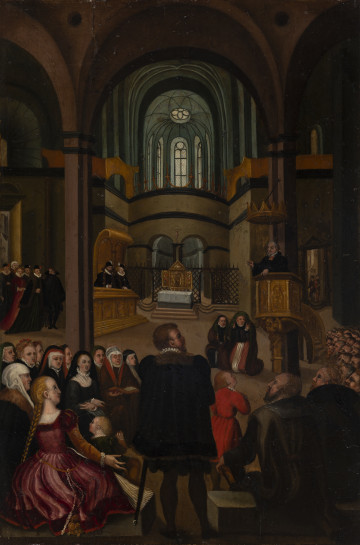
‘King Herod’ puppet from the Nativity scene
1901 — 1920
National Museum in Lublin
Part of the collection: European painting
'Storia (history) will touch the viewers' hearts only when the painted characters represent to the highest degree the stirrings of their spirit [...] we grieve with those who are sad, smile at those who laugh and feel compassion for those who suffer’, wrote Leon Battista Alberti in 1435.
As a painting theme taken up by numerous artists of the modern era, storia was held in the highest esteem. The artist chose a mythological, allegorical or biblical subject interesting enough to stimulate courtly conversation. It often aimed to revive the intensity of the religious experience. Flemish painting of the 17th century abounded in both monumental and intimate, small-format paintings. In the Baroque era, collectors bought small compositions for the then-fashionable kunstkamer, i.e., art rooms. Small religious paintings were often placed in private chapels.
Franz Francken the Younger specialised in small paintings usually painted on copper sheets or boards. He had a large workshop and thus many disciples and followers. The picture from the Lublin collection was painted in Antwerp, in the valued artist's circle, by his imitator. The composition is stiff, almost graphic, lacking consistent use of perspective and chiaroscuro. The figures in the painting The Feast of Herod are dressed in historicist-oriental costumes. Salome is the only figure wearing a dress made following the fashion of the 17th century. It distinguishes her as the protagonist of the plot that led to the prophet John the Baptist's martyrdom. By denouncing Herod's immoral relationship with Herodias, John incurred the king's wrath, which led to his imprisonment. Salome, Herodias' daughter, enchanted the king with her dancing so much that he agreed to give her John the Baptist's decapitated head.
Magdalena Norkowska
Author / creator
Dimensions
cały obiekt: height: 64 cm, width: 50 cm
Object type
painting
Technique
oil technique
Material
plank, oil-based paint
Creation time / dating
Creation / finding place
Owner
The National Museum in Lublin
Identification number
Location / status

1901 — 1920
National Museum in Lublin

3. ćwierć XVI wieku
National Museum in Szczecin
1819
National Museum in Lublin
DISCOVER this TOPIC
National Museum in Szczecin
DISCOVER this PATH
Educational path